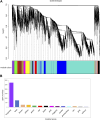A delayed and unsynchronized ovary development as revealed by transcriptome of brain and pituitary of Coilia nasus
- PMID: 38665935
- PMCID: PMC11043543
- DOI: 10.3389/fmolb.2024.1361386
A delayed and unsynchronized ovary development as revealed by transcriptome of brain and pituitary of Coilia nasus
Abstract
Coilia nasus is an anadromous fish that has been successfully domesticated in the last decade due to its high economic value. The fish exhibits a delayed ovary development during the reproductive season, despite breeding and selection for five to six offspring. The molecular mechanism of the delayed ovary development is still unknown, so the obstacles have not been removed in the large-scale breeding program. This study aims to investigate the key genes regulating ovarian development by comparing the transcriptomes of ovarian-stage IV and stage II brain/pituitary of Coilia nasus. Ovarian stages were validated by histological sections. A total of 75,097,641 and 66,735,592 high-quality reads were obtained from brain and pituitary transcriptomes, respectively, and alternatively spliced transcripts associated with gonadal development were detected. Compared to ovarian Ⅱ- brain, 515 differentially expressed genes (DEGs) were upregulated and 535 DEGs were downregulated in ovarian Ⅳ- brain, whereas 470 DEGs were upregulated and 483 DEGs were downregulated in ovarian Ⅳ- pituitary compared to ovarian Ⅱ- pituitary. DEGs involved in hormone synthesis and secretion and in the GnRH signaling pathway were screened. Weighted gene co-expression network analysis identified gene co-expression modules that were positively correlated with ovarian phenotypic traits. The hub genes Smad4 and TRPC4 in the modules were co-expressed with DEGs including Kiss1 receptor and JUNB, suggesting that ovarian development is controlled by a hypothalamic-pituitary-gonadal axis. Our results have provided new insights that advance our understanding of the molecular mechanism of C. nasus reproductive functions and will be useful for future breeding.
Keywords: Coilia nasus; RNA-seq; gonad; pituitary; weighted gene co-expression analysis.
Copyright © 2024 Yu, Gao, Zeng, Li, Xu, Ren, Zhu and Liu.
Conflict of interest statement
The authors declare that the research was conducted in the absence of any commercial or financial relationships that could be construed as a potential conflict of interest.
Figures








References
LinkOut - more resources
Full Text Sources
Miscellaneous

